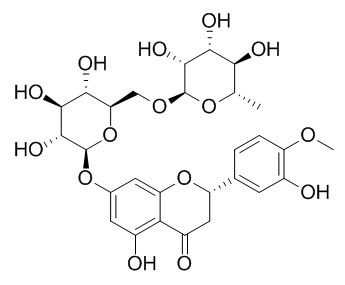Natural Products
Hesperidin
| Catalog No. | CFN98839 |  |
| CAS No. | 520-26-3 | |
| Molecular Weight: | 610.6 | |
| Molecular Formula | C28H34O15 | |
| DBs | [PubChem]:274951666 [ChEMBL]:28775 [PCIDB]:970 |
Standard InChI:
InChI=1S/C28H34O15/c1-10-21(32)23(34)25(36)27(40-10)39-9-19-22(33)24(35)26(37)28(43-19)41-12-6-14(30)20-15(31)8-17(42-18(20)7-12)11-3-4-16(38-2)13(29)5-11/h3-7,10,17,19,21-30,32-37H,8-9H2,1-2H3/t10?,17-,19?,21-,22+,23?,24-,25-,26?,27+,28+/m0/s1
Biological Activity
Hesperidin, a bioflavonoid, is an abundant and inexpensive by-product of Citrus cultivation, has antioxidant, anti-inflammatory, hypolipidemic, vasoprotective and anticarcinogenic and cholesterol lowering actions; can improves the health of capillaries by reducing the capillary permeability; can inhibit following enzymes: phospholipase A2, lipoxygenase, HMG-CoA reductase and cyclo-oxygenase. [1]
Hesperidin supplementation and diosmin individually or in combination, is effective in inhibiting the development of oesophageal cancer induced by MNAN, such inhibition might be related to suppression of increased cell proliferation caused by MNAN in the oesophageal mucosa.[2]
Hesperidin contributes to the vascular protective effects of orange juice.[3]
Hesperidin has beneficial effects on bone and lipids, can inhibit bone loss in ovariectomized mice (OVX), an animal model of postmenopausal osteoporosis.[4]
Hesperidin improves biomarkers of oxidative stress and has a hypocholesterolemic effect in an animal model of diet-induced hypercholesterolemia.[5]
Product
References
[1] Garg A, Garg S, Zaneveld L J D, et al. Phytotherapy Research Ptr, 2001, 15(8):655-69.
[2] Tanaka T, Makita H, Kawabata K, et al.Carcinogenesis, 1997, 18(4):761-9.
[3] Morand C, Dubray C, Milenkovic D, et al. Am J Clin Nutr, 2011, 93(1):73-80.
[4] Chiba H, Uehara M, Wu J X, et al.J Nutr, 2003, 133(6):74-75.
[5] Mostafa M, El-Shafey, Mohamed F. Int J Pharma Sci. 2014, 4(3): 554-55.
[6] Han S, Mok S Y, Kim H M, et al. 농업과학연구, 2011, 38(2):295-299.
Product Use Citation





